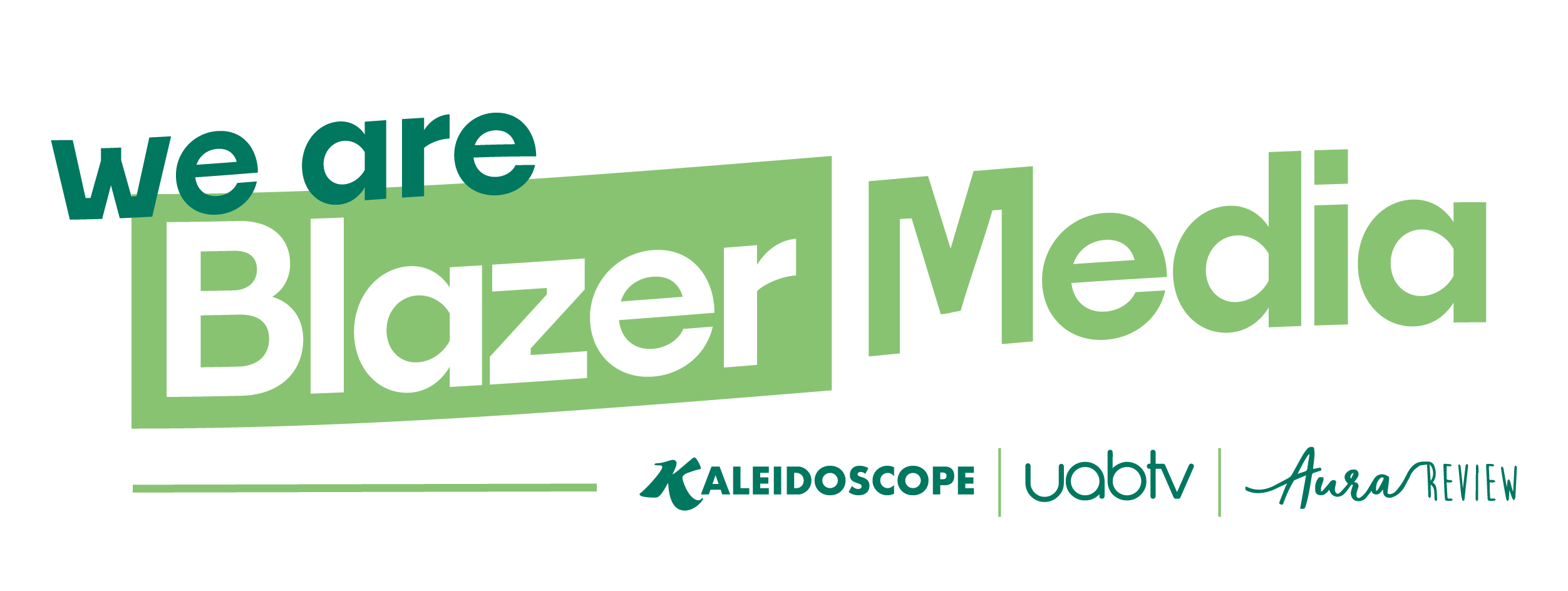
A design on the wall captives elements of Jessica Angel’s installment at Abroms-Engel Institute for the Visual Arts. Photo by Ian Keel/Photo Editor
– By Tessa Case, Managing Editor
The white walls of the Abroms-Engel Institute for the Visual Arts are no more, as well as the clear distinction between where the physical space ends or begins, and that’s before you put on the 3D glasses.
Black and multicolored vinyl span the walls, the ceiling and the floor in “Facing the Hyperstructure,” a large-scale installation project led by Colombian native and New York-based artist Jessica Angel.
Angel, who just finished her 15-week residency overseen by Curator John Fields, was aided by five UAB students: Alex Kulick, Camille Goulet, James Clay, Augusta McKewen and Alex Whitehead. The team was also aided by AEIVA staff and volunteers.
“‘Facing the Hyperstructure,’ I saw it as kind of a challenge when I [saw] it on the class list,” Clay, a senior bachelor’s of fine arts with a concentration in new media, said. “I saw it as uncharted territory for me, so I was like, I’m going to conquer the hyperstructure.”
The late Lisa Tamiris Becker, founding director of AEIVA, approached Angel in 2014 after one of Angel’s lectures at the University of New Mexico. The UAB College of Arts and Sciences Dean’s Office and the UAB Department of Art and Art History also aided in developing the site-specific installation, according to the information programme. The project was designed to foster cross-disciplinary initiatives between science, music, philosophy and new media.
“[We wanted] anyone who showed a genuine enthusiasm for the project,” Fields said. “I tried to make it sound like it was going to be tough. I felt like anyone who was still interested after hearing what I had to say about what the project would entail, that they would probably be a good fit for the class.”
The upper-level course came with departmental prerequisites, and each student had to have permission from their instructors to sign up for the course as well as a recommendation letter from a professor. Fields also spoke personally with at least one of the student’s professors.
“I was really excited to work with a female artist, being a female artist,” Goulet, a senior BFA with a concentration in photography, said. “That was really important to me, and how many women were in the class was surprising because I thought it would be mostly male students.”
McKewen, a senior BFA with a concentration in print-making, said she was immediately drawn to the project, but that Angel’s excitement and enthusiasm are what really sold her. McKewen also said that her experience with print-making helped prepare her for the project, as print-making is an extremely sensitive process. She credits that experience in giving her an attention to detail and respect for the material that allowed her to recognize the flaws and assets of vinyl and to take advantage of them.
The project, which Goulet describes as “the inner workings of an artistic mind,” opened March 31, welcoming 500 people, according to Fields.
“Come and support all the events,” Kulick, a senior BFA with a concentration in new media, said. Kulich was also responsible for the majority of posts on the project’s blog hyperstructure.info. “There are eight events in conjunction with this space and they’re all totally insane. A lot of hard work went into this.”
Remaining events include sound design being played every first and third Saturday through July, a film screening of “Brazil” May 11 and projected animation and drawing animation June 8. Goulet said that incorporating the community and public programming was a large part of the project.
Angel described herself as an advocate for art as a sensorial phenomenon and something that strikes a nerve.
“I found it really interesting how [Angel] decided to interpret the unfolding of space on a two-dimensional plane,” Kulick said. “It was interesting and beautiful how everything came together and displayed itself. It taught me a lot about perspective and looking at things from different perspectives because there’s no set way to interpret anything.”
The exhibit is rife with vinyl-layering that eliminates the horizon line and images of portals that generate the idea of stepping through the wall. Goulet commends the discussion of networks and connections that allowed these ideas to come to life, particularly the discussion of four-dimensional objects and space that developed into the tunnels.
The last day to view the exhibition will be July 29.
“Working with this team, I want to thank them and tell them it was a really great experience for me,” Angel said. “I hope it doesn’t end here.”
Tessa Case can be reached at managing@insideuab.com or on Twitter @tessedup.
